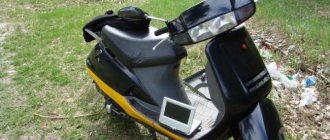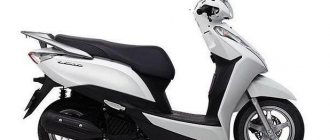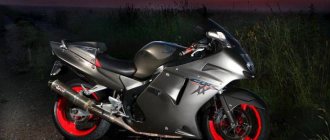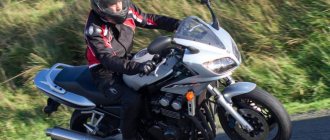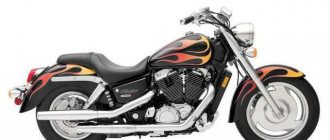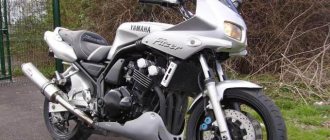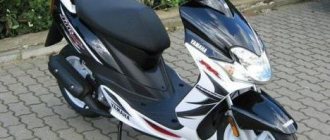- Honda motorcycle model
The Honda XL 650 V Transalp enduro touring motorcycle model was produced from 2000 to 2007. and replaced the previous generation of Transalp - Honda XL600V Transalp. Unlike its predecessor, the new model had a more modern appearance, a new dashboard, a new exhaust system, 2-disc front brakes, a more powerful engine and less off-road suspension.
The main feature of the Honda XL650V Transalp is a 2-cylinder V-shaped 6-valve liquid-cooled engine producing 53 hp. power and 55 Nm of torque. Like previous generations of the motorcycle, the engine of the 650 cc Transalp is tuned for smooth traction from low and medium speeds, showing maximum performance at 5500-7500 rpm. This engine was not a new development, but migrated from the Honda Bros 650 model and was also installed on the Honda NT 650 Deauville tourist.
Other features of the Honda XL650V Transalp include a classic steel frame, a 5-speed gearbox, a double-disc front brake, a chain drive, simple suspension in the form of a conventional telescopic fork and a monoshock absorber, and 191 kg of dry weight.
"Transalp" I, model 1987
The very first Honda Transalp motorcycle was released back in 1987 and is still in production. For almost 30 years, this “SUV” has evolved several times in design and technical terms, but the philosophy of a quiet bike for long roads has remained unchanged. The ideologically correct Transalp is a motorcycle covered in road dust with voluminous panniers and high touring glass. And its pilot is a seasoned tourist, accustomed to the hardships of the road, and easily covers about a thousand kilometers per day. Reviews of the new bike quickly spread around the world, contributing to the growth of its popularity.
The photo above shows the '87 model. Looking at it, you can see that the concept of the bike remains unchanged today.
The target audience
Honda Transalp, like most touring-enduros, most often becomes the choice of those who have already ridden more than one thousand kilometers. It is purchased by those who are tired of high-speed but demanding sports, or by those who are tired of the imposing slowness of the chopper. Sometimes fans of regular enduros grow up to tours - maneuverable and sharp, but not tough enough for long-range driving.
And reviews from those who switched to Transalp, having driving experience, usually concern the following qualities of the touring-enduro:
- maneuverability in urban conditions;
- excellent handling in forests, steppes, and hilly areas;
- endurance on a long journey;
- pilot and passenger comfort;
- average “appetites” for fuel and consumables;
- nice design;
- ample opportunities for tuning;
- availability of spare parts, network of service centers.
But the first Transalp bike is quite rare. Old bearded bikers say that you need to mature before it.
This does not mean that driving a Honda Transalp motorcycle is fraught with any problems. It’s just that this category of bikes is very specific.
Prices
Today, original Honda Transalp spare parts can be purchased at service centers almost everywhere. This is one of the advantages of the brand. Honda always takes care of expanding its dealer networks and service centers. Buying a new original motorcycle is also not a problem. The price level rather places this model in the middle category, both in the motor market as a whole and among other products of Honda itself.
First of all, the price depends on the year the motorcycle was manufactured and the degree of wear and tear. For example, a 400 can cost 90 thousand. But it’s worth looking for Transalp XL600 if you have at least 140 thousand rubles. The XL650 will cost an average of 180-190 thousand, and the XL700 is unlikely to be cheaper than 260 thousand rubles.
XL650
“Transalps” with 650 cc engines were assembled in Italy in the period 2000-2008. They have more streamlined plastic. Their power is 52 liters. s., which is 2 liters. With. more than the previous version of the Honda Transalp. Reviews indicate that the XL600 model is more suitable for highways rather than off-road, and for those who like to “drive”, the “six hundred” is better suited.
There is an opinion that the 650 is more demanding in maintenance. In order to make simple repairs, you will need to remove the plastic. However, it is the XL650 that is flooding the market; finding a 600 is problematic these days.
In 2005, the new model underwent some changes. They affected exclusively the design: the saddle, handlebars, and some parts of the body kit were modernized.
Chassis and brakes
The bike is equipped with a steel frame. It is half-duplex in type. The design is discreet, but interesting and stylish, as ideally a touring enduro should have it. The XL 400 V has spoked wheels, and the steering wheel is comfortable and efficient.
The rear suspension is pendulum with monoshock absorber. Its stroke is 187 mm. The front suspension has a travel of 200 mm and is a telescopic fork with dimensions of 41 mm. The rear brakes feature a single 240 mm disc and a single-piston caliper. At the front, the brake is a larger disc with dimensions of 276 mm, and the caliper here is two-piston.
Advantages
The very first thing that worries everyone who decides to start getting acquainted with the Honda Transalp motorcycle is the technical characteristics. They are largely similar for all models. The heart of the bike is a powerful and reliable V-shaped engine, the resource of which is designed for 300 thousand km or more. An experienced pilot will be able to accelerate the Transalp to hundreds in just 5 seconds, and the maximum speed is 170-180 km/h. Comfortable cruising speed should not exceed 140 km/h.
A powerful suspension makes it possible not to slow down in front of obstacles in the form of bumps or speed bumps. A motorcyclist on a Honda Transalp can even jump at full speed onto a curb or jump over an impressive branch (but, of course, not a cut tree). Our roads are an ideal place where the frisky character and enormous potential of Transalp can be demonstrated in all its glory.
The pilot's seating position is comfortable, he will not have to slouch, and his legs will not become numb in an uncomfortable position. In addition, the motorcyclist is positioned relatively high, which gives him the opportunity to see the road over the roofs of cars. This is an undeniable advantage in preventing emergency situations. The second number is also unlikely to complain about life, even on a long trip.
Tuning
When thinking about tuning, start from the goals and objectives that you set for your iron horse. On a long journey, elements such as a mesh for the headlight, hand protection, and comfortable, roomy trunks can be very useful. Think about the safety arches, because the Honda Transalp is still too plastic. In the event of an accident, their role cannot be overestimated.
Some install voluminous windshields - this also makes long journeys much easier. Lovers of comfort, especially those whose motorcycle season is not limited to three summer months, often acquire such a useful option as heated grips. There are also wide possibilities for tuning in the field of design. All of the above can be boiled down to one thing: every motorcycle owner can “customize” their favorite “Honda Transalp” to suit themselves, taking into account their own ideas about beauty, reliability and comfort.

